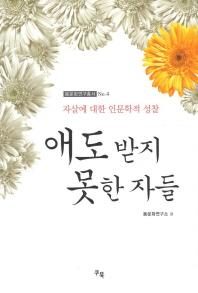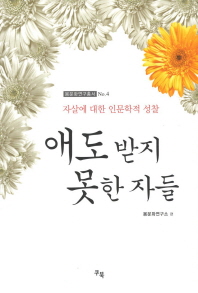- 글번호
- 910354
The Un-Mourned
- Writer
- 몸문화연구소
- View
- 59
- Date
- 2018.06.01
- 수정일
- 2024.04.03


Series Book - The Un-mourned
Suicide has become a national concern, not a personal matter. Unlike in the past, we began
to look at suicide as a normal event as well as a matter relevant to nearly everyone. We have
come to recognize and criticize the reality that the pressures of society's excessive competition,
economic hardship, unemployment, and loss of self-esteem are driving individuals to suicide.
The book The Un-mourned presents a solution from a humanities perspective to the lack of bonds
and bonds that are the problems of modern people's death.
The Un-mourned consists of Part 1, "Why People Commit Suicide?" Part 2, "Who Commits Suicide?"
Part 3, "How to Interpret Suicide." Part 1 'Why People Commit Suicide?' explains why youth suicide
is a more severe problem than among older people. It also analyzes adolescent girls who begin to be
presented as a weak creature who is suffering from depression and anxiety based on the discourse
of the girl's suicide. Finally, the author proposes a new ecological community to solve the problem
of elderly suicide and highlight the problem of suicide in the 20th century new novels. Part 3, 'How
to interpret suicide' describes why people should understand suicide as an active act of communication
with others, not as a solitary act of an individual disconnected from others. By analyzing the suicide note,
the author sheds new light on the process leading to suicide. "The View of the Law on Suicide"
describes the law on suicide in other countries. Through Hwang Hye Jin's literary work, the readers will be
able to rethink suicide. In the last chapter, "Love, Conflict, and Suicide," the author wants to find more
about the healing of suicide through literary works and seeks to examine the possibility of treating
pain, injury, and despair through literature.
Suicide has become a national concern, not a personal matter. Unlike in the past, we began
to look at suicide as a normal event as well as a matter relevant to nearly everyone. We have
come to recognize and criticize the reality that the pressures of society's excessive competition,
economic hardship, unemployment, and loss of self-esteem are driving individuals to suicide.
The book The Un-mourned presents a solution from a humanities perspective to the lack of bonds
and bonds that are the problems of modern people's death.
The Un-mourned consists of Part 1, "Why People Commit Suicide?" Part 2, "Who Commits Suicide?"
Part 3, "How to Interpret Suicide." Part 1 'Why People Commit Suicide?' explains why youth suicide
is a more severe problem than among older people. It also analyzes adolescent girls who begin to be
presented as a weak creature who is suffering from depression and anxiety based on the discourse
of the girl's suicide. Finally, the author proposes a new ecological community to solve the problem
of elderly suicide and highlight the problem of suicide in the 20th century new novels. Part 3, 'How
to interpret suicide' describes why people should understand suicide as an active act of communication
with others, not as a solitary act of an individual disconnected from others. By analyzing the suicide note,
the author sheds new light on the process leading to suicide. "The View of the Law on Suicide"
describes the law on suicide in other countries. Through Hwang Hye Jin's literary work, the readers will be
able to rethink suicide. In the last chapter, "Love, Conflict, and Suicide," the author wants to find more
about the healing of suicide through literary works and seeks to examine the possibility of treating
pain, injury, and despair through literature.
- 이전글
- Grotesque Body